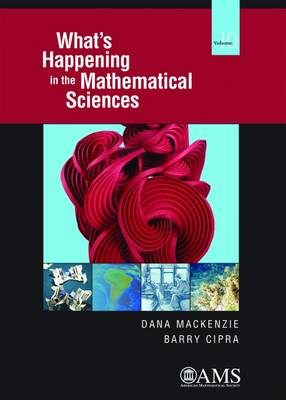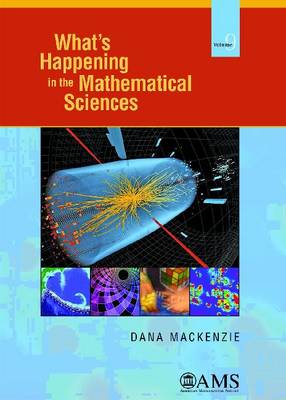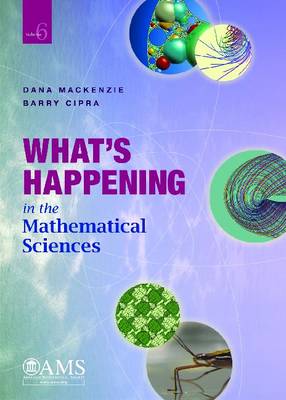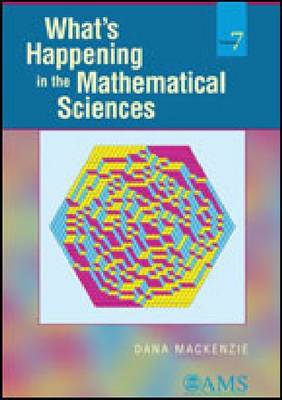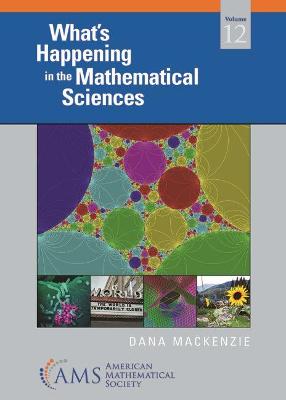What's Happening in the Mathematical Sciences
7 total works
What's Happening in the Mathematical Sciences, Volume 10
by Dana Mackenzie and Barry Cipra
Published 30 December 2015
What's Happening in the Mathematical Sciences is a collection of articles highlighting some of the most recent developments in mathematics. These include important achievements in pure mathematics, as well as its fascinating applications.
On the pure mathematics side, ``Prime Clusters and Gaps: Out-Experting the Experts'' talks about new insights into the distribution of prime numbers, the perpetual source of new problems, and new results. Recently, several mathematicians (including Yitang Zhang and James Maynard) significantly improved our knowledge of the distribution of prime numbers. Advances in the so-called Kadison-Singer problem and its applications in signal processing algorithms used to analyze and synthesize signals are described in ``The Kadison-Singer Problem: A Fine Balance''. ``Quod Erat Demonstrandum'' presents two examples of perseverance in mathematicians' pursuit of truth using, in particular, computers to verify their arguments. And ``Following in Sherlock Holmes' Bike Tracks'' shows how an episode in one of Sir Arthur Conan Doyle's stories about Sherlock Holmes naturally led to very interesting problems and results in the theory of completely integrable systems.
On the applied side, ``Climate Past, Present, and Future'' shows the importance of mathematics in the study of climate change and global warming phenomena. Mathematical models help researchers to understand the past, present, and future changes of climate, and to analyze their consequences. ``The Truth Shall Set Your Fee'' talks about algorithms of information exchange in cyberspace. Economists have known for a long time that trust is a cornerstone of commerce, and this becomes even more important nowadays when a lot of transactions, big and small, are done over the Internet. Recent efforts of theoretical computer scientists led to the development of so-called ``rational protocols'' for information exchange, where the parties in the information exchange process find that lies do not pay off.
Over the last 100 years many professional mathematicians and devoted amateurs contributed to the problem of finding polygons that can tile the plane, e.g., used as floor tiles in large rooms and walls. Despite all of these efforts, the search is not yet complete, as the very recent discovery of a new plane-tiling pentagon shows in ``A Pentagonal Search Pays Off''. Mathematics can benefit coaches and players in some of the most popular team sports as shown in ``The Brave New World of Sports Analytics''. The increased ability to collect and process statistics, big data, or ``analytics'' has completely changed the world of sports analytics. The use of modern methods of statistical modeling allows coaches and players to create much more detailed game plans as well as create many new ways of measuring a player's value. Finally, ``Origami: Unfolding the Future'' talks about the ancient Japanese paper-folding art and origami's unexpected connections to a variety of areas including mathematics, technology, and education.
On the pure mathematics side, ``Prime Clusters and Gaps: Out-Experting the Experts'' talks about new insights into the distribution of prime numbers, the perpetual source of new problems, and new results. Recently, several mathematicians (including Yitang Zhang and James Maynard) significantly improved our knowledge of the distribution of prime numbers. Advances in the so-called Kadison-Singer problem and its applications in signal processing algorithms used to analyze and synthesize signals are described in ``The Kadison-Singer Problem: A Fine Balance''. ``Quod Erat Demonstrandum'' presents two examples of perseverance in mathematicians' pursuit of truth using, in particular, computers to verify their arguments. And ``Following in Sherlock Holmes' Bike Tracks'' shows how an episode in one of Sir Arthur Conan Doyle's stories about Sherlock Holmes naturally led to very interesting problems and results in the theory of completely integrable systems.
On the applied side, ``Climate Past, Present, and Future'' shows the importance of mathematics in the study of climate change and global warming phenomena. Mathematical models help researchers to understand the past, present, and future changes of climate, and to analyze their consequences. ``The Truth Shall Set Your Fee'' talks about algorithms of information exchange in cyberspace. Economists have known for a long time that trust is a cornerstone of commerce, and this becomes even more important nowadays when a lot of transactions, big and small, are done over the Internet. Recent efforts of theoretical computer scientists led to the development of so-called ``rational protocols'' for information exchange, where the parties in the information exchange process find that lies do not pay off.
Over the last 100 years many professional mathematicians and devoted amateurs contributed to the problem of finding polygons that can tile the plane, e.g., used as floor tiles in large rooms and walls. Despite all of these efforts, the search is not yet complete, as the very recent discovery of a new plane-tiling pentagon shows in ``A Pentagonal Search Pays Off''. Mathematics can benefit coaches and players in some of the most popular team sports as shown in ``The Brave New World of Sports Analytics''. The increased ability to collect and process statistics, big data, or ``analytics'' has completely changed the world of sports analytics. The use of modern methods of statistical modeling allows coaches and players to create much more detailed game plans as well as create many new ways of measuring a player's value. Finally, ``Origami: Unfolding the Future'' talks about the ancient Japanese paper-folding art and origami's unexpected connections to a variety of areas including mathematics, technology, and education.
What's Happening in the Mathematical Sciences looks at some highlights of the most recent developments in mathematics. These include the mathematics behind stories that made headlines, as well as fascinating mathematical stories that never made it into the newspapers.
In 2009, a flu pandemic, the world's first in more than 40 years, tested a new generation of mathematical models that take some of the guesswork out of public health decisions. As health officials rushed to quell the outbreak of H1N1 flu, mathematicians were working just as hurriedly to answer questions like these: Was the epidemic serious enough to justify school closings or quarantines? Who should be vaccinated first, the elderly or the young? Their findings substantially affected the response of local governments, national governments, and the World Health Organization.
Mathematics can also help society prepare for other kinds of natural and manmade disasters. A major tsunami in 2011 in Japan, like the one seven years earlier in the Indian Ocean, highlighted flaws in our understanding of these catastrophic events and inadequacies in our early warning systems. Geoscientists are working together with mathematicians to improve our short-term forecasting ability and quantify the long-term risks of tsunamis. Meanwhile, in California, another group of mathematicians succeeded in adapting earthquake prediction algorithms to forecast criminal activity. Their ""predictive policing"" software was tested in Los Angeles and is being adopted by other cities across the United States.
Fortunately, not all mathematics has to do with emergencies. Pure mathematicians have been busy cleaning out their closets of long-standing open problems. In 2012, two conjectures about different kinds of minimising surfaces were solved: the Willmore Conjecture (minimising energy) and the Lawson Conjecture (minimising area). Also in 2012, following up on the extraordinary proofs of the Poincare Conjecture and Thurston's Geometrization Conjecture, topologists proved a collection of conjectures that ensure that three-dimensional spaces can all be constructed in a uniform way. Meanwhile, for the last ten years, a new way of understanding algebraic curves and surfaces has developed, leading to a subject now known as tropical geometry. With the new ideas, certain hard problems in algebraic geometry suddenly become easy and certain ""mathematical mysteries"" of string theory begin to make sense.
In physics, the nine-billion-dollar search for the elusive Higgs boson finally bagged its quarry in 2012. This discovery, one of the most widely publicised science stories of the year, provides experimental evidence for the ""Higgs mechanism,"" a nearly 50-year-old mathematical argument that explains how certain subatomic particles acquire mass.
Rounding out this volume are chapters on a new statistical technique called topic modelling, which is breaking down the academic barriers between math and the humanities, and new discoveries about mathematicians' (and a lot of other people's) favourite toy: the Rubik's Cube.
In 2009, a flu pandemic, the world's first in more than 40 years, tested a new generation of mathematical models that take some of the guesswork out of public health decisions. As health officials rushed to quell the outbreak of H1N1 flu, mathematicians were working just as hurriedly to answer questions like these: Was the epidemic serious enough to justify school closings or quarantines? Who should be vaccinated first, the elderly or the young? Their findings substantially affected the response of local governments, national governments, and the World Health Organization.
Mathematics can also help society prepare for other kinds of natural and manmade disasters. A major tsunami in 2011 in Japan, like the one seven years earlier in the Indian Ocean, highlighted flaws in our understanding of these catastrophic events and inadequacies in our early warning systems. Geoscientists are working together with mathematicians to improve our short-term forecasting ability and quantify the long-term risks of tsunamis. Meanwhile, in California, another group of mathematicians succeeded in adapting earthquake prediction algorithms to forecast criminal activity. Their ""predictive policing"" software was tested in Los Angeles and is being adopted by other cities across the United States.
Fortunately, not all mathematics has to do with emergencies. Pure mathematicians have been busy cleaning out their closets of long-standing open problems. In 2012, two conjectures about different kinds of minimising surfaces were solved: the Willmore Conjecture (minimising energy) and the Lawson Conjecture (minimising area). Also in 2012, following up on the extraordinary proofs of the Poincare Conjecture and Thurston's Geometrization Conjecture, topologists proved a collection of conjectures that ensure that three-dimensional spaces can all be constructed in a uniform way. Meanwhile, for the last ten years, a new way of understanding algebraic curves and surfaces has developed, leading to a subject now known as tropical geometry. With the new ideas, certain hard problems in algebraic geometry suddenly become easy and certain ""mathematical mysteries"" of string theory begin to make sense.
In physics, the nine-billion-dollar search for the elusive Higgs boson finally bagged its quarry in 2012. This discovery, one of the most widely publicised science stories of the year, provides experimental evidence for the ""Higgs mechanism,"" a nearly 50-year-old mathematical argument that explains how certain subatomic particles acquire mass.
Rounding out this volume are chapters on a new statistical technique called topic modelling, which is breaking down the academic barriers between math and the humanities, and new discoveries about mathematicians' (and a lot of other people's) favourite toy: the Rubik's Cube.
What's Happening in the Mathematical Sciences, Volume 6
by Dana Mackenzie and Barry Cipra
Published 1 January 2007
The ""AMS"" series ""What's Happening in the Mathematical Sciences"" distills the amazingly rich brew of current research in mathematics down to a few choice samples. This volume leads off with an update on the Poincare Conjecture, a hundred-year-old problem that has apparently been solved by Grigory Perelman of St. Petersburg, Russia. So what did topologists do when the oldest and most famous problem about closed manifolds was vanquished? As the second chapter describes, they confronted a suite of problems concerning the 'ends' of open manifolds...and solved those, too. Not to be outdone, number theorists accomplished several unexpected feats in the first five years of the new century, from computing a trillion digits of pi to finding arbitrarily long equally-spaced sequences of prime numbers.Undergraduates made key discoveries, as explained in the chapters on Venn diagrams and primality testing. In applied mathematics, the Navier-Stokes equations of fluid mechanics continued to stir up interest. One team proved new theorems about the long-term evolution of vortices, while others explored the surprising ways that insects use vortices to move around. The random jittering of Brownian motion became a little less mysterious. Finally, an old and trusted algorithm of computer science had its trustworthiness explained in a novel way. Barry Cipra explains these new developments in his wry and witty style, familiar to readers of Volumes 1-5, and is joined in this volume by Dana Mackenzie. Volume 6 of ""What's Happening"" will convey to all readers - from mathematical novices to experts - the beauty and wonder that is mathematics.
What's Happening in the Mathematical Sciences showcases the remarkable recent progress in pure and applied mathematics. Once again, there are some surprises, where we discover new properties of familiar things, in this case tightly-packed tetrahedra or curious turtle-like shapes that right themselves. Mathematics also has played significant roles in current events, most notably the financial crisis, but also in screening for breast cancer. The Netflix competition to find a better algorithm for recommending videos to subscribers demonstrated how deeply mathematics is used behind the scenes in our everyday lives.Mathematicians have settled several important conjectures in the past few years. In topology, the recently solved Kervaire invariant conjecture tells us about exotic spheres in high dimension. The Weinstein conjecture, proved by Cliff Taubes, guarantees periodicity in certain important dynamical systems. A very old dynamical system--the game of billiards--received two innovative makeovers. First, mathematicians proved the existence of ""wandering"" trajectories in an inside-out version of the game, called ""outer billiards,"" which some researchers consider a toy model for planetary motion. Second, mathematicians proved two different versions of the Quantum Unique Ergodicity conjecture, which says that a quantum-mechanical billiard ball behaves, in the long term (and at high energies) similarly to a classical billiard ball. The proof uses ideas from pure number theory dating back to Ramanujan. Finally, in another area of statistical physics, mathematicians showed that the transition from an unmixed to a mixed system often happens, relatively speaking, in the blink of an eye.Dana Mackenzie, a science and mathematics writer, makes the mathematics and the applications easily comprehensible, by calling on common sense or on similar but familiar phenomena. The stories invite you into the exciting world of modern mathematics, with its thrill of discovery and the anticipation of what is still to come. Anyone with an interest in mathematics, from high school teachers and college students to engineers and computer scientists, will find something of interest here. The stories are well told and the mathematics is gripping.
Since 1993, the AMS has been publishing ""What's Happening in the Mathematical Sciences"", a series of lively and highly readable accounts of the latest developments in mathematics. This seventh volume describes some genuine surprises, such as the recent discovery that coin tosses are inherently unfair; a mathematical theory of invisibility that was soon followed by the creation of a prototype 'invisibility cloak'; and, an ultra-efficient approach to image sensing that led to the development of a single-pixel camera. The past few years have also seen deep results on some classical mathematics problems. For example, this volume describes a proof of the Sato-Tate Conjecture in number theory and a major advance in the Minimal Model Program of algebraic geometry. The computation of the character table of the exceptional Lie group $E_8$ brings 'the most beautiful structure in mathematics' to public attention, and proves that human persistence is just as important as gigabytes of RAM. The amazing story of the Archimedes Palimpsest shows how the modern tools of high-energy physics uncovered the centuries-old secrets of the mathematical writings of Archimedes. Dana Mackenzie, a science writer specializing in mathematics, makes each of these topics accessible to all readers, with a style that is friendly and at the same time attentive to the nuances that make mathematics fascinating. Anyone with an interest in mathematics, from high school teachers and college students to engineers and computer scientists, will find something of interest here. The stories are well told and the mathematics is compelling.
What's Happening in the Mathematical Sciences, Volume 11
by Dana Mackenzie
Published 30 December 2019
This new volume of What's Happening in the Mathematical Sciences features a rich selection of articles about recent topics in pure and applied mathematics.
"Expanding Horizons" and "Needles in an Infinite Haystack" explain new developments in the theory of expander graphs and in number theory (asymptotic Fermat's last theorem), respectively. "The SetR Game Has Met Its Match" presents a solution of the so-called Cap Set Conjecture, a statement about arithmetic progressions in finite vector spaces, which resulted from the mathematical analysis of the popular game "Set".
"The Shape of Data" and "Quantum Computers and Golden Gates" present recent advances in theoretical computer science and related areas of data science. The mathematical aspects of one of the most fascinating recent developments in general relativity, the discovery of gravitational waves, is discussed in "When Black Holes Collide".
Three articles talk about applications of mathematical methods in various aspects of everyday life: bike-sharing systems and ride-sharing services (like Lyft and Uber) in "The Mathematics of Commuting", weight control in "The Calculus of Calories", and an analysis of various partisan election practices in "Gerrymandering: Mathematics on Trial".
We anticipate that many readers will find an interesting topic to read about and, hopefully, more than one.
"Expanding Horizons" and "Needles in an Infinite Haystack" explain new developments in the theory of expander graphs and in number theory (asymptotic Fermat's last theorem), respectively. "The SetR Game Has Met Its Match" presents a solution of the so-called Cap Set Conjecture, a statement about arithmetic progressions in finite vector spaces, which resulted from the mathematical analysis of the popular game "Set".
"The Shape of Data" and "Quantum Computers and Golden Gates" present recent advances in theoretical computer science and related areas of data science. The mathematical aspects of one of the most fascinating recent developments in general relativity, the discovery of gravitational waves, is discussed in "When Black Holes Collide".
Three articles talk about applications of mathematical methods in various aspects of everyday life: bike-sharing systems and ride-sharing services (like Lyft and Uber) in "The Mathematics of Commuting", weight control in "The Calculus of Calories", and an analysis of various partisan election practices in "Gerrymandering: Mathematics on Trial".
We anticipate that many readers will find an interesting topic to read about and, hopefully, more than one.
As always, What's Happening in the Mathematical Sciences presents a selection of topics in mathematics that have attracted particular attention in recent years. This volume is dominated by an event that shook the world in 2020 and 2021, the coronavirus (or COVID-19) pandemic. While the world turned to politicians and physicians for guidance, mathematicians played a key role in the background, forecasting the epidemic and providing rational frameworks for making decisions. The first three chapters of this book highlight several of their contributions, ranging from advising governors and city councils to predicting the effect of vaccines to identifying possibly dangerous ""escape variants"" that could re-infect people who already had the disease.
In recent years, scientists have sounded louder and louder alarms about another global threat: climate change. Climatologists predict that the frequency of hurricanes and waves of extreme heat will change. But to even define an ""extreme"" or a ""change"", let alone to predict the direction of change, is not a climate problem: it's a math problem. Mathematicians have been developing new techniques, and reviving old ones, to help climate modelers make such assessments.
In a more light-hearted vein, Descartes' ""Homework"" describes how a famous mathematician's blunder led to the discovery of new properties of foam-like structures called Apollonian packings. ""Square Pegs and Squiggly Holes"" shows that square pegs fit virtually any kind of hole, not just circular ones. ""Much Ado About Zero"" explains how difficult problems about eigenvalues of matrices can sometimes be answered by playing a simple game that involves coloring dots on a grid or a graph.
Finally, ""Dancing on the Edge of the Impossible"" provides a progress report on one of the oldest and still most important challenges in number theory: to devise an effective algorithm for finding all of the rational-number points on an algebraic curve. In the great majority of cases, number theorists know that the number of solutions is finite, yet they cannot tell when they have found the last one. However, two recently proposed methods show potential for breaking the impasse.
In recent years, scientists have sounded louder and louder alarms about another global threat: climate change. Climatologists predict that the frequency of hurricanes and waves of extreme heat will change. But to even define an ""extreme"" or a ""change"", let alone to predict the direction of change, is not a climate problem: it's a math problem. Mathematicians have been developing new techniques, and reviving old ones, to help climate modelers make such assessments.
In a more light-hearted vein, Descartes' ""Homework"" describes how a famous mathematician's blunder led to the discovery of new properties of foam-like structures called Apollonian packings. ""Square Pegs and Squiggly Holes"" shows that square pegs fit virtually any kind of hole, not just circular ones. ""Much Ado About Zero"" explains how difficult problems about eigenvalues of matrices can sometimes be answered by playing a simple game that involves coloring dots on a grid or a graph.
Finally, ""Dancing on the Edge of the Impossible"" provides a progress report on one of the oldest and still most important challenges in number theory: to devise an effective algorithm for finding all of the rational-number points on an algebraic curve. In the great majority of cases, number theorists know that the number of solutions is finite, yet they cannot tell when they have found the last one. However, two recently proposed methods show potential for breaking the impasse.
